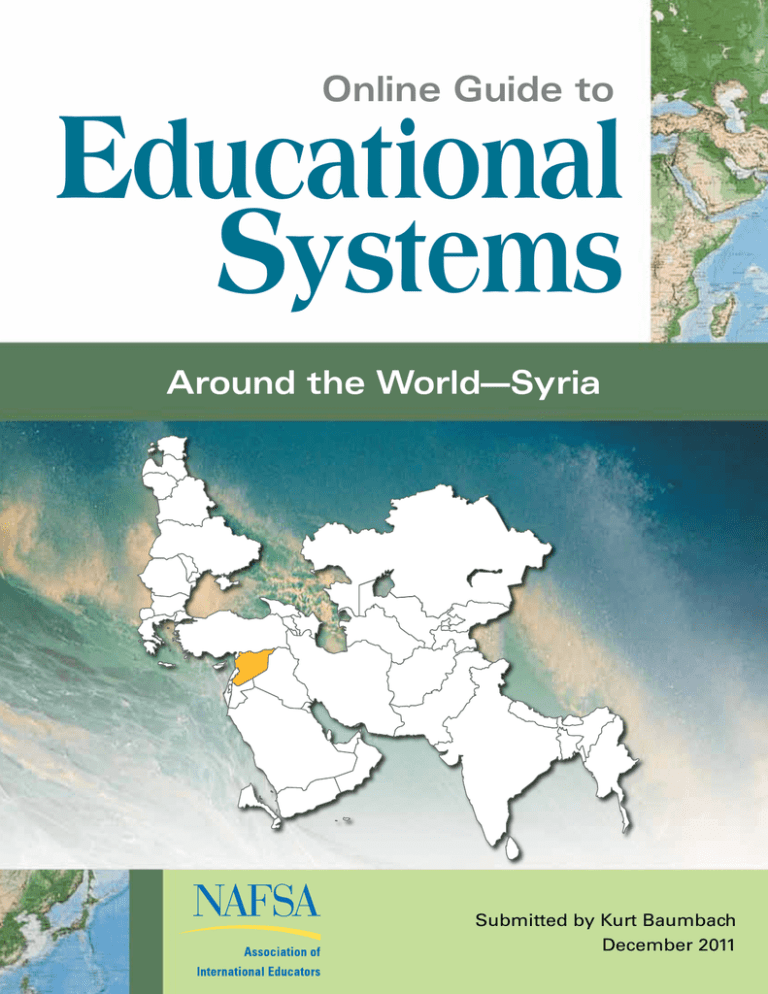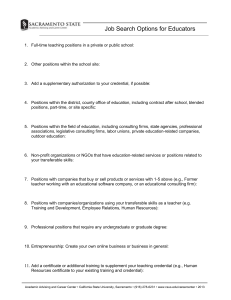
Online Guide to
Educational
Systems
Around the World­—Syria
Submitted by Kurt Baumbach
December 2011
About NAFSA
NAFSA: Association of International Educators is a member organization promoting international education and
providing professional development opportunities to the field. Hundreds of NAFSA members volunteer to serve
the Association and thousands advocate for international education. NAFSA serves international educators and
their institutions and organizations by establishing principles of good practice, providing training and professional
development opportunities, providing networking opportunities, and advocating for international education.
For more information about NAFSA, visit www.nafsa.org.
In 1948, NAFSA pioneered the concept of providing professional services for postsecondary exchange
students. Early efforts to enhance living and learning environments for exchange students have blossomed into
today’s active association of accomplished professionals whose numbers continue to grow worldwide.
Notice of Liability
The information in these documents is distributed on an “As is” basis, without warranty. While every precaution
has been taken in the preparation of each document, neither the submitter(s) nor NAFSA shall have any liability
to any persons nor entity with respect to any loss or damage caused or alleged to be caused directly or
indirectly by the information contained in any of these documents. Information about each country was current
at the time of upload. Education systems change periodically and updates will be written to reflect significant
changes, once known. Please note that while NAFSA periodically verified the Web site links included in these ePublications, NAFSA cannot guarantee that every link will be current at the time of download.
Acceptable Use Guidelines
Electronic resources are provided for the benefit of the international education community. However,
commercial use, systematic or excessive downloading, or electronic redistribution of these publications are all
expressly prohibited.
© 2011 NAFSA: Association of International Educators. All rights reserved.
Online Guide to Educational Systems Around the World
1
Instructions for Using the Online Guide to
Educational Systems Around the World
Susan Whipple, Editor
May 2011
These documents are updates to those in the 1999 publication A Guide to Educational Systems Around
the World (which was an update to The Handbook on the Placement of Foreign Graduate Students,
published in 1990 and colloquially known as the "Graduate Handbook.")
It is important to note that these documents do not replace either of the earlier publications, which
should be used for credentials issued prior to 1999, the period those publications cover.
Readers familiar with the original version of A Guide to Educational Systems Around the World will note
that these updates use the same format:
1. Each of these publications provides lists of credentials and other data that can be used both for
undergraduate and graduate admissions.
2. "Advice for admissions officers" is intentionally not provided. We have attempted to avoid all
types of subjective interpretation, relying instead on objective data. Users of these updates
should use the information provided in conjunction with other resources to determine their own
placement recommendations and possibility of transfer credit. Questions about credentials can
be posted on the Admission and Credential Evaluation discussion forum on the Recruitment,
Admissions, and Preparation Knowledge Community: http://www.nafsa.org/aceforums. For
information on how to subscribe to the network, please visit www.nafsa.org/networksubscribe.
Please note that these updates should be supplemented by additional written materials that describe
complete foreign educational systems, including data on specific institutions, and by professional training
in the theory and practice of credential evaluation. Many of these resources are available from NAFSA,
either as printed publications or on-line. The need for institution support for budgetary resources and
training for undergraduate and graduate admissions personnel remains important, regardless of the
increased availability of resources on the Web.
These publications were compiled by many authors using a standardized template and style. Although
minor variations among entries do occur, the basic guidelines are explained as follows:
Educational Ladder
2
Online Guide to Educational Systems Around the World
The year or half-year at which a credential is awarded is the point at which the corresponding credential
letter is placed. In the example above, credential A is awarded after the 9th year of education. Note that
the corresponding letter is placed directly below the number 9.
All normal possibilities of the total number of years of education that a credential might require are
indicated on the ladder. This occurs for credential B, in which the credential can be awarded after either
12 or 13 total years of education. An explanation is provided in the description of the credential whenever
a letter appears on the ladder more than once. There are a few cases when this multiple-listing style was
not used; in these cases, there are explanatory comments.
An arrow () is used after a credential letter in cases where no maximum length of study for a particular
program is specified, or where the study time is open-ended. For example, a doctor of philosophy degree
program may require a minimum of three years of enrollment. The corresponding credential letter with an
arrow will appear under the minimum number of total years of education required to earn the Ph.D.
Explanations About Documents
Credentials are divided into two categories: secondary and postsecondary. The decision to include the
credential under one or the other category is not a subjective one—a credential is determined to be either
secondary or postsecondary according to its designation by the country of origin, regardless of how
individual institutions might perceive the level (and recommend transfer credit).
Numerical endnotes, placed directly after the complete list of credentials, are used when a lengthy
explanation about a credential is necessary.
Foreign Terms and Words
Foreign terms are used whenever possible, and are translated literally, in most cases. Literal translations
are used to avoid subjectivity. We have attempted to be consistent with translations across languages,
though readers may notice some differences between countries because of preferences indicated by the
submitters. Credential evaluators and admissions personnel should always rely on official foreign
language documents, using translations only as guides.
Grading lnformation
Only the most common grading scales used in each country are listed. Evaluators understand that
variations in grading are common and that one should always consult the grading information that may be
provided on official transcripts. Rather than making grade equivalency statements, the submitter(s) of the
update provided information regarding grading practices within the countries.
Online Guide to Educational Systems Around the World
3
SYRIA
YEARS OF EDUCATION →
1
2
1
2
1
2
1
2
1
2
1
2
1
2
1
2
1
2
1
2
1
2
1
2
1
2
1
2
1
2
1
2
1
2
1→6 │7 │ 8 │9 │10 │11 │12 │13 │14 │15 │16 │ 17 │18 │ 19 │ 20 │ 21 │ 22 │ 23 │ 24
A B
E G H
I
K
M N
P→
C
F
J J
J
M
N P→
D
G
K
N
L
O
M
CREDENTIALS OR DOCUMENTATION
Secondary
A
B
C
D
Vocational Secondary Certificate or Professional Secondary Certificate: represents 11
years of education (nine years of primary / lower-secondary, two years of vocational /
professional secondary) – grants access to employment but not to postsecondary study
General Secondary Certificate or Certificate of General Secondary Education (commonly
known as the Baccalaureate): represents 12 years of education (nine years of primary /
lower-secondary, three years of academic secondary in literature or science tracks and
passing of a national examination) – grants access to postsecondary study
Technical Secondary Certificate or Certificate of Technical Secondary Education:
represents 12 years of education (nine years of primary / lower-secondary, three years
of industrial, commercial, agricultural, or home economics-specialized secondary and
passing of a national examination) – grants limited access to postsecondary study
Religious Secondary Certificate (nine years of primary / lower-secondary, three years of
religious secondary) – grants limited access to postsecondary study
Postsecondary
E
F
G
H
I
J
K
L
4
Certificate of Licensed Assistant, Associate Degree, Industrial Institute Diploma,
Technical Assistant: two years, requires Credential B or C – religious institutes require
Credential D
Teaching Certificate for Primary Education or Primary Teaching Certificate, Teacher
Training Diploma, Physical Education Diploma, Intermediate Teaching Certificate: two
years, requires Credential B
Nursing Certificate or Certificate of Licensed Assistant in Nursing: two or three years
(most commonly three years), requires Credential B
Bachelor’s degree (sometimes known as the Licence): four years for most academic
fields, requires Credential B
Bachelor’s degree: five years for engineering, pharmacy, architecture, dentistry or
veterinary medicine, requires Credential B
Specialized Nursing Certificate in Midwifery, Surgery or Pediatrics: one or two years,
requires Credential G
Diploma of Qualification and Specialization or Special Diploma: one year, requires
Credential H or I
Educational Qualifying Diploma: one year of study in a teacher certification program,
requires Credential H
Online Guide to Educational Systems Around the World
M
Diploma of Higher Studies or Postgraduate Diploma: one or two years, requires
Credential H or I
Master’s degree: one to three years in total, requires either credential H or I (two or three
years) or Credential M (one or two years)
Bachelor’s degree: six years for medicine, requires Credential B
Doctorate: two or three years (minimum), requires Credential N
N
O
P
GRADING SCALES
Secondary
Minimum passing score for Arabic: 50%
Minimum passing score for other subjects: 40%
•
•
Passing the general secondary examination requires a passing score in Arabic and in all
but one of the other subjects, or a passing score in Arabic and all but two of the other
subjects as long as the combined score for the failed subjects is at least 25%.
The minimum passing total score is 102/240 (43%) in the literature track, and 104/260
(40%) in the science track.
Postsecondary
Intermediate Institute Grading Scale
(for university-affiliated institutes)
Score
Remark
85-100
Excellent
75-84
Very Good
65-74
Good
40-64 or 50-64
Pass
•
•
Passing scores are 60% in applied or practical subjects, 50% in technical subjects, and
40% in theoretical subjects
Intermediate institutes not affiliated with a university use a grading scale similar to that
used at the secondary level
Undergraduate Grading Scale
Score
Remark
90-100
Honors
80-89
Distinction
70-79
Very Good
60-69
Good
50-59
Passing
•
Grading is conservative, and often the top students score in the high 60’s.
Online Guide to Educational Systems Around the World
5
Graduate Grading Scale
Score
Remark
95-100
Honors
85-94
Distinction
75-84
Very Good
65-74
Good
60-64
Passing
POSTSECONDARY INSTITUTION RECOGNITION BODY
Ministry of Higher Education
PO Box 9251
Damascus
SYRIA
Telephone: 963 112119865, 963 112119961, 963 112119962
Email: mhe@mhe.gov.sy
RESOURCES FOR ADDITIONAL INFORMATION
Print
de Leeuw, Herman. “Intermediate Institutes in Syria.” World Education News and Reviews, 9,4:
11-17, 1996.
Feagles, Shelley M., editor. A Guide to Educational Systems Around the World. Washington,
DC: NAFSA, 1999.
The New Country Index, Volume 2; International Education Research Foundation (IERF), 2011
Syria: A Comparative Study; National Office of Overseas Skills Recognition (NOOSR –
Australia), 1992.
On-line
AACRAO EDGE – Electronic Database of Global Education: http://aacraoedge.aacrao.org/
Ministry of Higher Education listing of approved institutions of higher education in Syria:
http://www.mhe.gov.sy/new/index.php?page=show&ex=2&dir=docs&lang=2&ser=1&cat=1168&r
ef=home
Submitted by
Kurt Baumbach
Academic Evaluation Services, Tampa
December 2011
6
Online Guide to Educational Systems Around the World

